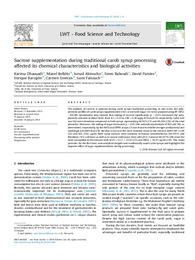Por favor, use este identificador para citar o enlazar este ítem:
https://hdl.handle.net/11000/34351Registro completo de metadatos
| Campo DC | Valor | Lengua/Idioma |
|---|---|---|
| dc.contributor.author | Dhaouadi, karima | - |
| dc.contributor.author | Belkhir, Manel | - |
| dc.contributor.author | Akinocho, Ismail | - |
| dc.contributor.author | RABOUDI, Faten | - |
| dc.contributor.author | Pamies, David | - |
| dc.contributor.author | Barrajón-Catalán, Enrique | - |
| dc.contributor.author | Estevan Martinez, Carmen | - |
| dc.contributor.author | Fattouch, Sami | - |
| dc.contributor.other | Departamentos de la UMH::Biología Aplicada | es_ES |
| dc.date.accessioned | 2025-01-11T14:26:10Z | - |
| dc.date.available | 2025-01-11T14:26:10Z | - |
| dc.date.created | 2014 | - |
| dc.identifier.citation | LWT | es_ES |
| dc.identifier.issn | 1096-1127 | - |
| dc.identifier.uri | https://hdl.handle.net/11000/34351 | - |
| dc.description.abstract | The addition of sucrose is optional during carob syrups traditional processing. In this work, the polyphenolic profiles of carob syrups supplemented (CSS) or not with sugar (CS) were analyzed using RP-HPLC eESI-MS. Quantitative data showed that adding of sucrose significantly (p < 0.05) decreased the polyphenolic amounts of about 58.6%, from 4.5 0.32 to 1.86 0.26 mg/g of CS and CSS, respectively. Gallic acid was the most abundant compound in both syrups representing 60.93% (CS) and 69.26% (CSS) of the total phenolics. Moreover, the adding of sugar decreased (p < 0.05) the antiradical potentials of 28% and 74%, as determined, respectively, by the ABTS and DPPH assays. CS was found to exhibit stronger antibacterial and antifungal activities than CSS. Bacillus cereus was the most sensitive strain to the extracts with CMI z500 (CS) and 622 (CSS) mg/ml. Both syrup extracts were cytotoxic to human neuroblastoma (SH-SY5Y) and fibroblast (3T3) cell lines as well as to mouse embryonic stem cells (D3). Tumoral SH-SY5Y cells were the most susceptible to the extracts with IC50 ¼ 311.7 23.65 (CS) and 390.6 34.97 mg/ml (CSS). This study provides, for the first time, new analytical insights into traditionally made carob syrups and highlights the negative effect of sugar supplementation during processing. | es_ES |
| dc.format | application/pdf | es_ES |
| dc.format.extent | 8 | es_ES |
| dc.language.iso | eng | es_ES |
| dc.publisher | Elsevier | es_ES |
| dc.relation.ispartofseries | 57 | es_ES |
| dc.relation.ispartofseries | 1 | es_ES |
| dc.rights | info:eu-repo/semantics/openAccess | es_ES |
| dc.rights.uri | http://creativecommons.org/licenses/by-nc-nd/4.0/ | * |
| dc.subject | Carob syrup | es_ES |
| dc.subject | Cell cytotoxicity | es_ES |
| dc.subject | Sucrose supplementation | es_ES |
| dc.subject | Chromatographic analysis | es_ES |
| dc.subject | Polyphenols | es_ES |
| dc.subject.other | CDU::5 - Ciencias puras y naturales::57 - Biología::573 - Biología general y teórica | es_ES |
| dc.title | Sucrose supplementation during traditional carob syrup processing affected its chemical characteristics and biological activities | es_ES |
| dc.type | info:eu-repo/semantics/article | es_ES |
| dc.relation.publisherversion | https://doi.org/10.1016/j.lwt.2014.01.025 | es_ES |

Ver/Abrir:
Sucrose supplementation during traditional carob syrup processing affected its chemical characteristics and biological activities (1).pdf
551,14 kB
Adobe PDF
Compartir:
 La licencia se describe como: Atribución-NonComercial-NoDerivada 4.0 Internacional.
La licencia se describe como: Atribución-NonComercial-NoDerivada 4.0 Internacional.
.png)